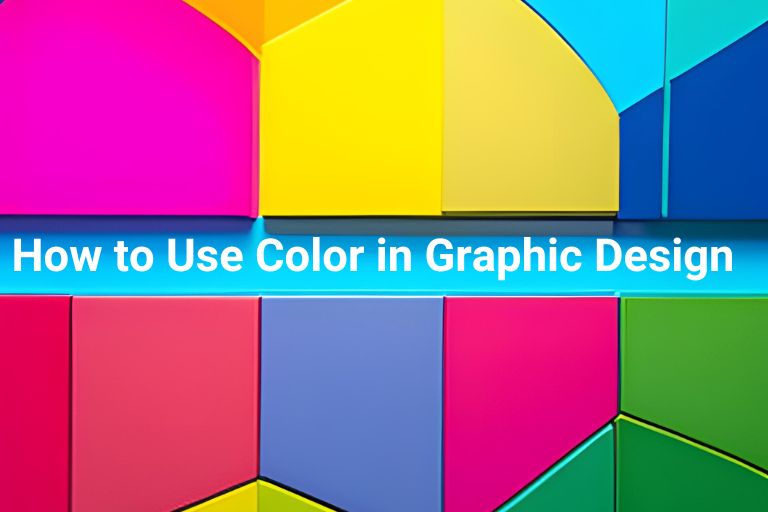
If you’re a graphic designer, you know that one of the most important elements of any project is color. Whether you’re designing a logo, website, or print materials, the colors you choose will have a major impact on the overall look and feel of the finished product. With so much at stake, it’s essential to understand the basics of color theory to make the best decisions for your design. This comprehensive guide will provide you with everything you need to know about types of color in graphic design and how to use it effectively.
Table of Contents
1) Introduction: What is color theory and why is it important?
Color theory is a set of principles used in the design and composition of colors to create visual harmony and interest. It is a fundamental part of graphic design, helping designers to create beautiful and effective visuals. Color theory helps designers understand the relationship between colors and how they affect each other. By understanding how colors interact, designers can use color to create eye-catching visuals and evoke certain emotions in viewers. Understanding color theory is essential for anyone looking to become an effective graphic designer.
2) The basics of color: hue, value, and chroma
Understanding the fundamentals of color is key when it comes to graphic design. The three most important concepts in color theory are hue, value, and chroma. Hue is simply the name of a color, such as blue or red. Value is the lightness or darkness of a color, with light being high value and dark being low value. Chroma is the intensity of a color, with more intense colors being higher chroma and muted tones being lower chroma. Knowing how these three elements work together is essential for creating visually appealing designs.
3) The color wheel and color harmony
Color harmony can be defined as the use of a combination of colors that creates a sense of visual balance and cohesiveness. At the core of this concept is the color wheel, which consists of 12 hues that can be used to create various color combinations. It’s important to understand how each color in the wheel relates to the others, and how they work together. The color wheel can help you identify complementary, analogous, square, triadic, and monochromatic color palettes, allowing you to create the perfect balance for your design. With some practice and experimentation, you can use the color wheel to make sure your designs are aesthetically pleasing and full of harmonious hues.
4) Complementary colors
Complementary colors are located directly opposite each other on the color wheel. This creates a stark contrast and brightens up any design. For example, combining yellow and purple or orange and blue will create an eye-catching result. When using complementary colors, it’s important to adjust the values so that the colors don’t overwhelm each other. Subtlety is key to maintaining a balanced look. Complementary colors can also be used to emphasize specific elements of a design, such as making certain objects stand out against a neutral background. With the right combination of colors, complementary colors can be a great way to add impact to your designs.
5) Analogous colors
Analogous colors are colors that are next to each other on the color wheel. They often have a soothing, harmonious look because of their similarities. Analogous colors are great for creating a feeling of unity, balance, and harmony in your design. To create an analogous palette, choose three colors that are side-by-side on the color wheel. Examples of analogous colors include blue and green, red and orange, and yellow and green. These can be further modified by adjusting the tints and shades of each hue to create a more dynamic design. With an analogous color palette, you can create aesthetically pleasing designs that remain cohesive.
6) Triadic colors
Triadic colors are three colors spaced evenly around the color wheel. These colors create a visually balanced and aesthetically pleasing effect when used in designs. They can be either warm or cool, depending on the colors used. For example, red, yellow, and blue are triadic colors that have a cool temperature.
On the other hand, pink, purple, and orange are triadic colors that have a warm temperature. When using these colors in the design, they should be equally balanced to create visual harmony. They also work well with neutral colors, like black or white, to create beautiful visuals. With the right combination of triadic colors, you can create bold and striking designs.
7) Square colors
Square colors are created by arranging four colors in a rectangular pattern. This pattern is also referred to as tetradic or double complementary. This type of color scheme is made up of two pairs of complementary colors, located opposite one another on the color wheel.
When using square colors, it is important to maintain a balance between the two pairs to avoid a visually overwhelming and confusing composition. A successful composition with square colors should be able to bring out the individual beauty of each color while working together harmoniously. To achieve this balance, you can choose one of the four colors as the dominant color, while keeping the other three as accents.
8) Achromatic colors
Achromatic colors refer to shades of black, white, and grey. They are made without any hue and therefore have no color in them. Achromatic colors can be used to create a sense of depth and shadow, as well as being a great choice for monochromatic designs. These colors are often used for backgrounds and borders, but can also be used as focal points. When using achromatic colors, be careful not to use too much black or white; try using greys instead for a more balanced look. Remember, achromatic colors create a sophisticated and modern vibe that is perfect for many different types of designs.
9) Monochromatic colors
A monochromatic color scheme is made up of one single hue and its various tints and shades. By using different values of the same hue, you can create a pleasing composition with a lot of impacts. Monochromatic color schemes are typically associated with minimalism, but they can be used to great effect in a wide variety of designs. Using the same hue throughout a design creates cohesion, making it look like all of the elements belong together. Experiment with different saturation levels and textures to create a unique look.
10) Warm colors
Warm colors include hues such as red, orange, yellow, and combinations of these. They are often associated with energy, vibrancy, and a sense of comfort. When used in the design, warm colors can create an inviting atmosphere and evoke feelings of warmth and joy. When combining warm colors, use shades and tints to create a harmonious composition. It is important to note that too much warm color can be overwhelming, so use them sparingly. For example, adding pops of bright red or yellow can create interesting contrast against neutral backgrounds. With the careful use of warm colors, you can create unique and powerful designs.
11) Cool colors
Cool colors are made up of blues, greens, and purples. These colors are often associated with a calming effect, as well as a sense of stability and depth. When combined with warmer tones, cool colors can create an atmosphere of harmony and balance. When using cool colors, it’s important to keep in mind the dominance and strength of the hue. Too much blue can be overwhelming, while a pale green can appear lifeless. Keep your designs fresh by using the full range of cool colors. Remember to use contrasts to make your design pop.
12) Earth tones
Earth tones are a type of natural color scheme that involves various shades of brown, green, yellow, and orange. Earth tones are often associated with nature and are ideal for conveying a natural and organic feel. Earth tones can be used to create a warm, homey atmosphere and make a space seem inviting and comfortable. This color palette is versatile and can be used for any project – from web design to interior design – as it offers a range of hues that work well together. Earth tones can be used alone or combined with other colors for a unique look.
13) Neutrals
Neutrals are colors that exist on the color wheel but are neither warm nor cool. They can include shades of black, white, gray, brown, and beige. These colors are often used to provide balance to a composition, as they don’t draw attention away from other colors. Neutrals tend to make a design look more professional and sophisticated. Be careful not to use too many neutrals in a single design, as it can make the design look dull and uninteresting. Incorporating neutrals into your designs can provide a harmonious look, but also add subtle visual interest.
FAQ
What is color theory, and why is it important in graphic design?
Color theory is a set of principles used to create visual harmony and interest in the design and composition of colors. Understanding color theory is essential for anyone looking to become an effective graphic designer.
What are the three most important concepts in color theory?
The three most important concepts in color theory are hue, value, and chroma.
What is the color wheel, and how does it relate to color harmony?
The color wheel consists of 12 hues that can be used to create various color combinations. It’s important to understand how each color in the wheel relates to the others and how they work together. The color wheel can help you identify complementary, analogous, square, triadic, and monochromatic color palettes, allowing you to create the perfect balance for your design.
What are complementary colors, and how can they be used in graphic design?
Complementary colors are located directly opposite each other on the color wheel. When used in designs, they create a stark contrast and brighten up any design. With the right combination of colors, complementary colors can be a great way to add impact to your designs.
What are analogous colors, and how can they be used in graphic design?
Analogous colors are colors that are next to each other on the color wheel. They often have a soothing, harmonious look because of their similarities. Analogous colors are great for creating a feeling of unity, balance, and harmony in your design.
What are triadic colors, and how can they be used in graphic design?
Triadic colors are three colors spaced evenly around the color wheel. They create a visually balanced and aesthetically pleasing effect when used in designs. They also work well with neutral colors, like black or white, to create beautiful visuals.
What are square colors, and how can they be used in graphic design?
Square colors are created by arranging four colors in a rectangular pattern. This pattern is also referred to as tetradic or double complementary. When using square colors, it is important to maintain a balance between the two pairs to avoid a visually overwhelming and confusing composition.
What are achromatic colors, and how can they be used in graphic design?
Achromatic colors refer to shades of black, white, and grey. They are made without any hue and therefore have no color in them. Achromatic colors can be used to create a sense of depth and shadow, as well as being a great choice for monochromatic designs.
What is a monochromatic color scheme, and how can it be used in graphic design?
A monochromatic color scheme is made up of one single hue. This type of color scheme is great for creating a cohesive look in your design. It’s important to adjust the tints and shades of the hue to create a more dynamic design.
If you are a Twitter lover then you will love this post Right Now 10 Most Followed Indians on X


